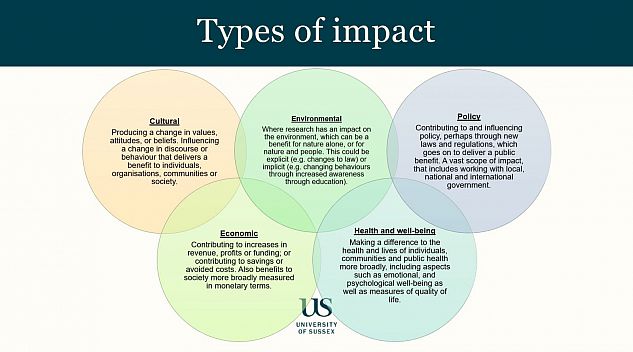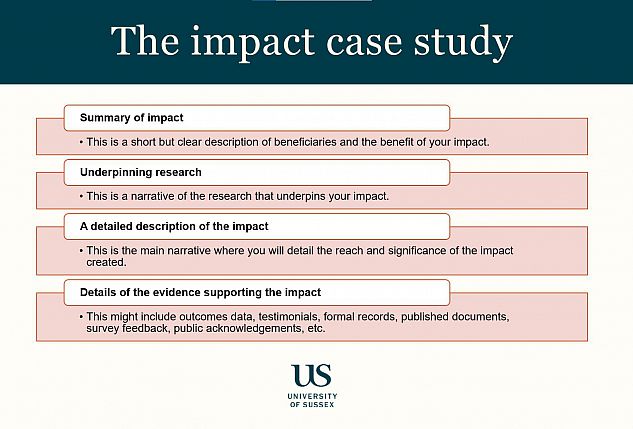What is research impact?
Welcome to the first page of our Research Impact Guidance toolkit. Below you’ll find an introduction to research impact, why it’s important, and how to achieve it. Once you’ve brushed up on research impact here, move on to the ‘Where to start’ page for more guidance on how to get started on your impact journey.
Research impact is the demonstrable or perceived benefit of your research beyond academia. It is the change that your research makes to someone or something (whether that be individuals, groups, organisations, and society at large) when your research outputs and findings make their way those who are relevant to and affected by your research outside of academia. This benefit must be causally linked to your research, and can be achieved through communication, engagement, collaboration and/or co-creation activity with your stakeholders. The more two-way the process, the better: your research will be more robust and relevant if you design your aims and methods around the reality of your stakeholders, while their capacity to use your research will be greater as a result.
- Type of impact
-
Impact can be achieved in many different settings. It can be direct or indirect, positive and negative and may refer to a change in understanding, a new produce, practice, policy, or system. It might be felt or understood immediately or develop over a much longer time frame. Below are some brief summaries of the most common types of impact:

There may be some that you are more naturally inclined to use to the nature of your research. But don’t feel like you need to be fixed to these ideas, you might be surprised where you can make an impact.
Be aware that impact does not happen in isolation, and different types of impact are often intertwined. In the interlinking circles above, we’ve shown how this might work in practice. For example, an environmental impact may lead to both a policy change and a change in discourse of behaviour. It’s always worth thinking about your impact journey in a non-linear way and think about how it could have crossovers into other areas to maximise your impact.
- Why is it important?
-
There are various reasons why research impact is important. The main being that is gives you the chance to see how your research is making a difference.
In fostering relationships with both academic colleagues and external partners, it can help you generate new collaborations and new ideas that can feed back into your research.
There are increasing expectations from funders that researchers will demonstrate the real world impact of their work. Since 2020, UKRI has made impact a core consideration of the entire grant application process, noting that all research grant and fellowship applications should consider how they will or might achieve impact outside of the academic community. You can find more RQI advice on including impact into your funding applications on the impact and funder requirements page.
Research impact can also help you develop your career as a researcher, with it increasingly included in recruitment and promotion criteria. It can also further develop your communication skills with a wider audience beyond academia and provide you with further project management experience.
- Impact and the REF
-
Research impact is an assessment criterion of the quality of research in the awarding processes of the Research Excellence Framework (REF). In REF2028 it will be worth 25% of the total outcome.
For the purposes of REF, impact is defined as ‘an effect on, change or benefit to the economy, society, culture, public policy or services, health, the environment of quality of life, beyond academia’. (REF2021 Guidance on submissions, Annex C, page 90)
The significance and reach of the impact is assessed in the REF. This is assessed through engagement and impact case studies which articulate a narrative link between the underpinning research and consequent impact. These case studies show the causal link between your research and impact, using evidence to show who benefited (the reach) and how they benefitted (the significance) from your research.
We do not currently know what an engagement and impact case study will look like for REF2028, but below is an overview of the REF2021 format:

- How to achieve research impact
-
Research impact is often the result of a variety of factors including timing, place and the conditions or environment in which your research is being carried out. There are many activities, planned or unplanned, that can lead to research leading to being taken up. Impact can also be triggered by the prevailing political, economic, and societal circumstances too. The following principles represent a starting point for considering the potential impact of your research:
Work with external partners from the beginning of your research project, and continue working with them throughout. Discussing research plans with external partners and working with them on an ongoing basis can aide the process of the uptake ad use of your research results.
Increase the accessibility of your research and findings by producing outputs that appeal to the key audiences you are targeting.
Increase the visibility of your research and findings by disseminating your research through different forms of engagement, especially ones that appeal to external audiences.
This engagement can take many different forms:
- Media (i.e. Research featured on a documentary; appearing in the news or on radio; debates; blog posts)
- Events (i.e. public engagement events, roundtables, workshops, non-academic conferences)
- Advisory (i.e. Contributions to parliamentary inquiries, reports, debates, boards, committees and groups etc.)
- Dissemination (i.e. policy or research briefs; reports; online resources)
- Collaborations with public, voluntary and independent sectors. (i.e., consultancy, commissioned research)
These are all potential pathways to impact. Impact is what happens next and the difference that these engagements have made.
The more widely your research is communicated and shared, the more likely it is for a range of beneficiaries to have the opportunity to react, respond, understand and perhaps apply the findings of your research.
- Misconceptions about impact
-
Below are some of the most common misconceptions about what researchers are required to do when it comes to research impact:
I have to predict the impact of my research: Funders are aware that research impact is complex by nature, that it takes time to evolve and that it depends on contextual factors. Considering (not predicting) routes to impact is a starting point for maximising the impact of research. For most funders, researchers need to describe what they plan to do in order to bring the research to a point where it is most likely to have impact.
Impact means a breakthrough discovery: Breakthroughs that respond to global challenges have a huge impact and are more visible in the lives of the people that are affected. They also tend to attract publicity. Nevertheless, there is equal value in the smaller-scale contributions of research. Claims and plans for impact are understood and assessed in the specific context of each discipline and reviewers are conscious that not all disciplines lend themselves equally well to impact.
I will still get the funding even without a good impact plan: To increase the chances for funding, an application needs to come across as strong across all sections and requirements. Given the competition levels, treating impact with equal rigour wins you funding points overall.
My research is theoretical, there is nothing to write about impact: There is nothing wrong with claiming exclusively academic impact where this is genuinely the case. Describing what makes the contribution to the field unique and its possible relevance for other disciplines makes a strong case for impact. You can design and describe academic activities that will maximise access to your findings and will therefore increase your academic impact. Impact requirements in application forms are more intended to encourage an honest assessment of the potential for impact be it academic, non-academic or both.
I have to come up with a commercial product in order to demonstrate impact: Developing products can be a complex and time-consuming process and there is no imperative to come up with products or to commercialise research results. Where this makes sense (e.g. drug development, software development) or where the call and funder specifically request it, commercialisation plans will be necessary in order to describe the routes to delivering benefits in the long term. Presenting a plan that shows how you might detect promising outcomes and activate routes for their exploitation early on would be well received by most funders. If you are not familiar with commercialisation routes and processes you are advised to seek support from the IBP team.
- Resources
-
What is research impact and why does it matter? [PDF 1020.08KB]
These slides form part of the RQI introduction to research impact workshop and highlight many of the key points above.


